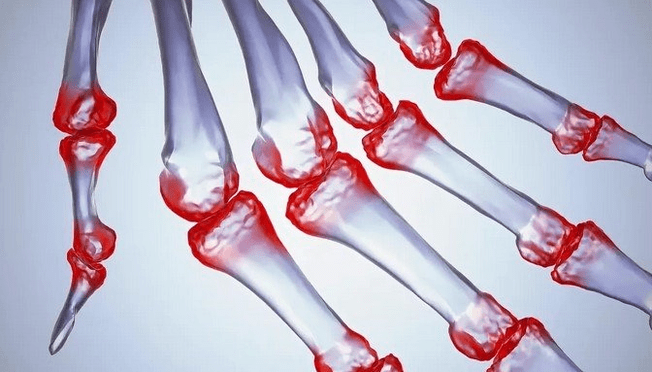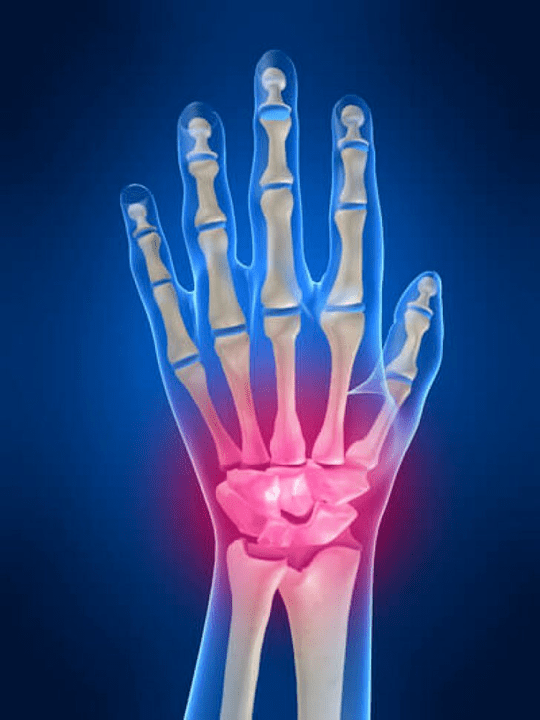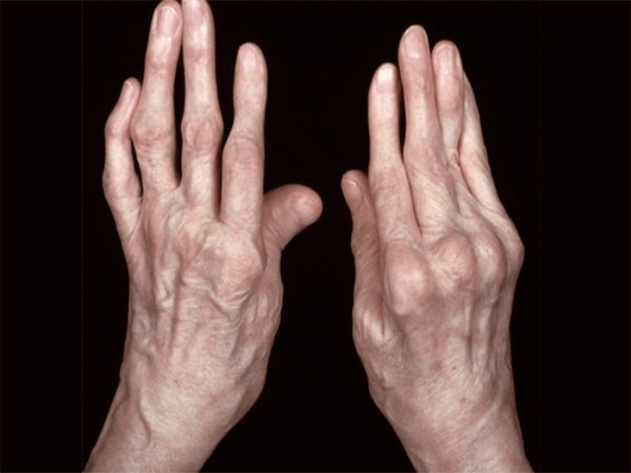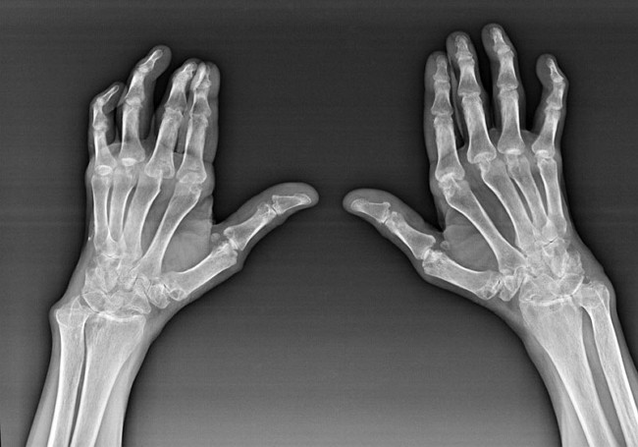
Joint painFinger is an indispensable sign of any joint disease in which the structural components of these joints are damaged.First of all, pain in the area of these joints can be associated with autoimmune diseasesSystemic red lust, rheumatoid arthritis, psoriasis, etc.) In which the immune factors cause damage to their own joint tissues.
The next main reason may beginpainIn the joints of the fingers, there may be wounds (Bruises, dislocations, fractures, ligaments).The pain in these joints can also be agitated by degenerative changes that occur in their joint tissues.This can often be observed with osteoarthritis.
Anatomy of the joints of the hand
All joints of the hand are divided into the following groups:
- wrist joints;
- joints of the wrist;
- Incarn tube joint;
- joint;
- PLememonal-Phalanx joints;
- Interphalanx joints.
Wrist joint
The wrist joint is formed by the bone of the bone near (above) some wrists (Trihedral, Semi -Moon, Scaphoid Bones) and remote areas of radiation and elbow bone.The elbow bones are not directly connected to the bones of the wrist, but with the help of the distance (Lower) Joint disk.This structure separates the compartment of the wrist joint with the distance (Lower) Brick joints.
Wrist joint
The joints of the wrist are represented by three types of joints.The first sample consists of joints between the bone of the upper part (Scaphoid, semi -moon, trihedral, pea -shaped) or lower rows (hook, head, trapezoidal head, bone trap).These joints are called joints.According to the second type, the middle joint is ranked.This joint is shaped in S -shaped and formed by the bone connection of the upper and lower row of the wrist.The third type includes the joints of bean bone.Through this joint, Trihedral bones are connected to bean bone.
Capacen-Penal couplings
The wrist tube joints connect the bone of the wrist and the metacarpal bone.These joints are formed by the contact of close heads (base) Metacarpal bone and remote parts of the second row wrist bone.The wrist tube -type joints include two main joints.The first is the wrist of the thumb.It is formed by the connection of the first metacarpal bone with bone trap.
The second joint is the common wrist tube joint for the rest of the wrist compounds between the second, third, fourth, third, fifth and trapezoidal methacarpal bones and trapezoidal bones, head bones and, part of the bone trap.The wrist model of the thumb is separated from the total number of wrists.Therefore, there may be more positive movements in it, compared to the rest of the wrist pipe (included in the joints of the wrist pipe in general) is considered little sedentary.The wrist tube joints are enhanced by strong joint capsules, as well as ligaments (Ligament back and hand ligament).
Joint interpreter
The side surfaces of the second, third, fourth and fifth metacarpal bones, when contacted by each other, forming Interprex joints.These joints have separate joint capsules, approaching the wrist tube capsules, connected to them.In addition to the capsules, these joints also have a ligament movement represented by the Metacarpal Inter -Scener ligament, as well as the rear ligament and Palmar.The joints are attributed to the static joints of the hand, because the joint surfaces of the bone forming these joints are flat shape.
Parleen-Phalanx
Parleus-phalanx joints are compounds between far away (lower) with the ends of metacarpal and close (above) The first phalang areas of the fingers of the hand.Each finger of the upper limb has its own metacarponal joint.Therefore, there are five phalancing metacarpal joints on each hand.
Interphalanx joint
Interpophalanx joints are formed by a combination of nearby phalangs of each finger.Large (Firstly) Fingers have only one joint joint, because this finger has only two phalanxes (near and far).The rest of the fingers of each hand has two joints.
First of all of them are localized between the first one (closest) and second (medium) fingers and is called close phalang (above) Interphalang joints.The second forms an average connection (Monday) and final (distant) Phalang finger.The second Interphalangeal joints are called far -ended joints.Inter -phalanx joints are enhanced with collateral and Palmar.These joints belong to the joints, the movements can only be around the front plane (Fighting and bending).

What structures can be inflamed in the joints of the hand?
Inflammation is a typical typical pathological process of tissues and organs damaged for any reason.The memorable thing is, in most cases, all diseases (For example, gout, rheumatoid arthritis, etc.) or injury damage the joints of the hand at one degree or the other, not only affects the joints, but also Perioster (nerves, muscles, tendons, subcutaneous fat, skin) Structure.
The following joint structures may be inflamed in the joints of the hand:
- articular cartilage;
- Squeeze bone tissue;
- capsules;
- General ligament.
The cause of the pain in the joints and fingers
The main sharing among the reasons for pain in the joints and fingers are occupied by mechanical trauma (Fracture, dislocated, bruises, etc.) and system autoimmune diseases (Rheumatoid arthritis, systemic lupus system, psoriasis, etc.).In addition to these causes, pain in the joints of the hand can cause diseases related to metabolic disorders (For example, gout, osteoarthritis).

There are the following main causes of pain in the joints and fingers:
- Bruises and fingers;
- fracture of the brush;
- dislocations of the brush;
- ligament damage of the hand;
- rheumatoid arthritis;
- Kinbek disease;
- Reactive arthritis;
- Gout;
- Psoriasis arthritis;
- Animal inflammation;
- joints;
- Red lupus system.
Bruises of brushes and fingers
Bruising is one of the types of closed injuries, including a lesions for soft tissues (muscles, tendons, nerves, skin) And no wounds in the main action of injury factor are oriented.The bruises of soft tissues of the hands and fingers are rarely found in isolation (private) From the bruises of the joints of the hand and fingers.Therefore, with this type of injury, the mixed symptoms are found, showing both lesions for the hands of the hand and the injury of the intravenous (Peri -Human) Fabric.The bruises of the brush and fingers are often found when falling in hand, damaging it with a blunt object, with its compression or compression.
Very often, the bruises of the cysts lead to damage to the main bodies of the average nerve, piercing, elbow (That innate hands and fingers), immediately manifested by losing skin sensitivity, and in some cases, even the disappearance of the movement functions of the fingers.
Inflammation of joint structures and peri -staff development due to the expansion of many vessels that they are providing blood.This edema is one of the reactions of inflammation, which occurs to cope with tissue damage during bruises.
A fracture of the brush
Very often, the cause of pain in the joints of the hand may be its different fractures, because these bones are directly recorded in the formation of joint surfaces.Depending on the anatomical position of the damaged bone, all fractures are divided into three main groups.The first group includes a wrist fracture.The second includes fracture of the tubular metacarpal bone.The third group includes the fracture of the finger phalang.
The most frequent damage places in the wrist area of the brush are semi -bone and scaphoid.A crack of these bones occurs while falling on the brush and accompanied by pain in the wrist and wrist joints on average.Pain syndrome can also be observed in the localized localized localization of the bones.
The most frequent fracture of the ends of the metacarpal bone is a crack of the root of the first metacarpal bone (The one is attached to the phalang of the thumb).With this injury, edema and aches appear in the area of the first Metatarsal bone, as well as in that part of the body of the car, directly adjacent to it.The thumb with such a fracture is shortened, bent and leads to your palm.His movement is limited.
Phalanx fracture of the brush comes with deformation, reducing the length of the fingers, losing their functions, pain and swelling in the Inter -phalanx joints and the Peri tissues.With the fracture of the fingers with the movement of the bone pieces, the touch (When touching) You can determine their bulging on the brush surface of the brush, and on the back, on the contrary, one hole or isolation.These fragments are usually mobile, near them you can often detect bleeding under the skin (Hematomas).
Dislocated brush joint
Deviation is a pathological condition in which bone areas form any joint beyond its anatomical boundary, so it is manifested by completely lost or part of the function of this joint.In addition to the weakening joint function during dislocations, severe pain in the joints affected, swelling and increased local temperature are also found.During the dislocations of the brush, the appearance of swelling is not only by the presence of inflammation in the Per -fertile tissue, as well as the structures of the joint, but also with the protrusion of the joints.
The most frequent dislocations of the brush
| Name of order | Mechanism of dislocations | Which joint is surprised? |
| The true order of the brush | The joints of the wrist bone are moved compared to the joint surface of the heartbone towards the palm of the hand or at the back of the hand. |
|
| Perilunar's dislocations | The bones of the wrist and the rest of the brush are changed compared to the midday bone and piercing the back of the brush. |
|
| Dislocate | At the same time, the scaphoid bone displays the dislocations on the parallel radiation side (In the same plane) to the nearby bone of the wrist.Sometimes it can change on the Palmar side, meaning switching to the palm of the bone, less often at the same side of the trapezoid bone. |
|
| Dislines of Semi -Moon | There is a slip of half -moon in the direction of the palm, so that the space in the position of this bone is not busy.It gradually occupied by the head bone, invading here from the second row of the wrist bone.This dislocation is a complication of the self -adjustment of Perilunar dislocations. |
|
| Dislines the first metacarpal | The joint surface of the bottom of the methacarpal bone was first moved to the joint surface of the bone trap on the radiation side, up (up (up (closest) and in the same plane with the bone of the wrist.Therefore, the thumb is pulled a bit and towards the wrist joint. |
|
| Dislines of the finger | There is a deviation of fingers in the metacarpophalange and phalanx joint joints.At first, the overall surface of the close phalanx of the finger (Along with all fingers) Moving compared to the joint surface of the metacarpal bone.With the second one, there is a shift between the bone of the phalang of the finger itself.Usually there is dislocated back and palms of the finger's phalang. |
|
Damage to the ligament of the hand
The ligament damage and bruises of the brush is attributed to closed injury injuries.This pathology is mainly found with an excessive expansion of the hands and fingers in any direction.The main types of lesions of the brush bundle are their prolonged and broken broken.With the extended in the damage area, light regeneration and partial breakage of the observed connective tissue fibers.With the broken ligament, the entire ligament is divided into two endless ends.
The following main types of brushes of the brush are distinguished:
- The broken ligament of the wrist's piercing collateral;
- the broken ligament of the wrist's elbow mortgage;
- interceptor ligament broken;
- Broken ligament of phalancing metacarpal joints;
- Broken ligament of Interphalang joints.
Rheumatoid arthritis
Rheumatoid arthritis is a disease in which human immune system damages the body's tissues.In other words, rheumatoid arthritis is an autoimmune disease.This disease also has a system, because many tissues are affected by it (Muscle, joints, ships, etc.) and agencies (Heart, kidney, lung, etc.) in the body.
Despite the fact that rheumatoid arthritis is a systematic disease, at a greater level, the joints are affected, while the damage of other tissues and organs is in the background.With this disease, almost all types of brush joints can be affected (Wrist, wrist tube, metacarpal-phalanx, joint phalanx).Ordinary injury (Those things.The same joints are affected) On both hands, accompanied by swelling, pain in damaged joints.In the morning, during the lifting process from the bed, there are some hardness in the affected joints, which can last for about 1 hour and then disappear without traces.
Quite often with rheumatoid arthritis near the affected joints of the brush (More often than piano-phalanx, phalanx) The low notes appear.They are a circular team lying under the skin.On the brush, these formations arise most often on the back.When touching, they are dense, not working, no pain.The number of them may change.
Kinbek disease
Kinbek's disease is a disease in which the wrist bone sold of the brush is affected.The development of the disease is the result of long -term physical overload of the palm.Normally it occurs in experts of the field of construction - plasters, Mason, participants, etc. ... The most physical activity of the palm is most often this bone, because it occupies the central position in the wrist joint.Most commonly, in Kinbek disease, the brush of one hand is affected and as prescribed,The right hand is broken, the left hand is broken).
Reactive arthritis
Reactive arthritis is a disease of immune genesis, in which its own immune system attacks different joints in the body, which is why autoimmune inflammation develops in them.Unlike other autoimmune diseases (For example, rheumatoid arthritis, systemic lupus erythematosus, in the appearance of an infectious origin) In reactive arthritis, the clear relationship between the infection is traced (And, in particular, the intestinal tract or urinary tract) and the development of joint lesions.
In addition, with this pathology, lymph nodes may increase and fever appears.When arthritis reacts to chronic form, over time, the patient may indicate signs of kidney, heart and muscle disease, bursic inflammation may occur (Electrical bag inflammation), Tendovaginites (Vaginitis of veins) and others.
Gout
Gout is a disease based on the development of uric acid accumulation in the body and its deposition in the form of salt in the joints.Uralgic acid is the final product of the metabolism of Purine and Pyrimidine.They serve as a basis for the construction of DNA and RNA molecules, some energy formation (Adenosine trifospphate, adenosine monophosphate, etc.) and vitamins.
Pain with gout mainly occurs in the small joints of the lower and top limbs.Moreover, in 50% of all clinical cases, the disease starts with the first added joint of the leg.In hand, as a rule, the joints of the fingers are affected, less often - radiant joints.Gout often damages one or more joints on one limb, sometimes the joints of other limbs are related to the inflammatory process.
Psoriasis arthritis
Psoriasis arthritis is a pathology in which different joints are inflamed on the background of psoriasis.The growth of psoriasis is based on a violation of the interaction between immune cells and skin cells due to the result in the body (And especially in the skin) There are autoimmune reactions that cause inflammation.
Animal inflammation
Active inflammation is an inflammation of the joints of the joints, accompanied by damage to its tissues and the accumulation of pathological liquids in the affected joints.Animal inflammation is not a separate disease, but a complication of other diseases.It can occur with hormonal diseases, allergies, infectious, autoimmune, brushes, etc.
Osteoarthritis
Osteoarthritis is a disease that violates the process of forming normal cartilage tissue in different joints.These processes are violated under the influence of some external and internal factors.They can be constant joint injuries, prolonged physical activity (At work, in everyday life, in sports), genetics, other joint diseases, etc.
The joints of the fingers are painful to this pathology, because in the right anglePeri -Human) The tissue occurs, the nerve is affected.A characteristic feature of osteoarthritis is the relationship of pain in physical activity.Pain in joints mainly appears at and/or after severe physical overload and disappears when resting or after rest.
Red lupus system
A systemic lupus erythematus is an autoimmune disease, in which the human body has a immune system of autoimmune antibodies, attacking different structures of cells and tissue.In particular, with it, the production of antibodies against SO -Handling causes damage to cell nuclear and DNA and RNA molecules observed.With red lupus, different types of fabrics and organs are affected - skin, ship, heart, pleura, pericardium, kidney, joint, etc.
The red lupus system is constantly associated with other additional signs - weak, weight loss, fever (Improve body temperature).However, special symptoms are of greatest importance, without diagnosis of red lupus is not done.These special signs are Quang Tu inflammation (Dermatitis under the influence of sunlight), Dance rash (The appearance on the neck, red chest), Lupoid butterfly (The appearance of red spots on the skin near the nose), erosion in the oral cavity, kidney damage (Glomerulonephritis), Serosites (Serum inflammation) and others.
Diagnosis of the cause of pain

Hand pain in the joints involved in diagnosis and treatment of the cause of pain, mainly an injury doctor and biologist.To diagnose such reasons, these doctors mainly use clinical (Anamnesis collection, external inspection, palpation, etc.), piercing (X -ray, calculation class cutting) and laboratory (General blood test, biochemical test, etc.) Research method.
Depending on the cause of pain in the joints, all diagnosis may be divided into the following parts:
- Diagnosis of injury injury of the brush (Bruises, dislocations, fractures, ligaments);
- Diagnosis of rheumatoid arthritis;
- Diagnosis of Kinbek disease;
- Diagnosis of reaction arthritis;
- Diagnosis of gout;
- Diagnosis of arthritis psoriasis;
- Diagnosis of epidemic inflammation;
- Diagnosis of osteoarthritis;
- Diagnosis of systemic lupus erythematosus.
Diagnosis of injury injury injury
When injury of the brush, you should consult your doctor.The main diagnostic methods are used in health practice to identify injuries for brushes (Fracture, dislocated, ligaments, bruises), is an external test, Anamnesis, radiation research method (X -ray, calculation class cutting).
Anamnests data collection allows the doctor to identify incidents that lead to or can lead to injury to the brush.Anamnesis's history is also used to clarify the symptoms that disturb patients.During the external test on the brush, swelling, hematoma, deformation, limiting the mobility of the joint.With the help of the touch, the doctor shows the presence of pain, violating the anatomical shape of the joint, damaging the ligament.Radiation research method (X -ray, calculation class cutting) They allow you to confirm the diagnosis, because in the process of using them, mechanical damage to the anatomical formation of the brush can be clearly seen.
Treatment of pathogens causing arthritis

To treat the cause of pain in the joints and fingers, first of all, the doctor, stipulating many types of drugs (Anti -inflammatory, analgesics, anti - -Rhevetas, etc.).In some cases, they combine the use of these products with physical therapy processes.Trauma damage to brushes is usually treated with surgery or applied to the upper limb affected by plasterboard.
To relieve pain and reduce inflammation, the first help may be the use of NSAID outside.Selective drugs block COO-2 and directly impact pain source.It was quickly absorbed by a special texture, leaving no traces of clothes, with a pleasant smell.
Depending on the disease that causes inflammation in the joints of the hand, all treatments may be divided into the following parts:
- Treatment of injury injury of the brush (Bruises, dislocations, fractures, ligaments);
- Treatment of rheumatoid arthritis;
- Treatment of Kinbek disease;
- Treatment of reactive arthritis;
- Treatment of gout;
- Treatment of arthritis psoriasis;
- Treatment of epidemic inflammation;
- Treatment of osteoarthritis;
- Treatment of systemic lupus erythematosus.
























